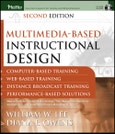Just as the groundbreaking first edition of Multimedia–Based Instructional Design offered a complete guide to designing and developing interactive multimedia training, the second edition is filled with relevant new content, automated tools on the erb site, updates on standards, and current case studies and demonstrations.
Praise for the second edition of Multimedia–Based Instructional Design
"Finally, the book I have longed for is on the shelf! The second edition of Multimedia–Based Instructional Design, by William W. Lee and Diana L. Owens, is strong on practice, grounded in proven theoretical principles, and chock–full of automated tools that make the instructional design process easy to learn and easy to apply."
Angela Benson, assistant professor, Department of Human Resource Education, University of Illinois, Urbana–Champaign
"There are many books about the development of e–Learning but very few that answer the question ′How do I do it?′ This book provides many answers to that question in a way that demonstrates both the authors knowledge of development theory as well as their practical, real–world mastery."
Thomas Toth, Certified Macromedia MX 2004 Developer; author, Technology for Trainers; and e–Learning designer and developer
Table of Contents
List of Figures and Tables xiii
Acknowledgments xvii
Introduction: Getting the Most from This Resource xix
PART ONE Multimedia Needs Assessment and Analysis 1
1 Introduction to Multimedia Needs Assessment and Front–End Analysis 3
2 Needs Assessment 6
3 Front–End Analysis 15
4 Audience Analysis 18
5 Technology Analysis 22
6 Situational Analysis 28
7 Task Analysis 31
8 Critical Incident Analysis 36
9 Issue Analysis 39
10 Objective Analysis 42
11 Media Analysis 55
12 Extant Data Analysis 73
13 Cost Analysis 77
14 Rapid Analysis Method 81
PART TWO Multimedia Instructional Design 91
15 Introduction to Multimedia Instructional Design 93
16 Project Schedule 104
17 Project Team 109
18 Media Specifications 116
19 Content Structure 129
20 Configuration Control 153
PART THREE Multimedia Development and Implementation 159
21 Introduction to Multimedia Development 161
22 Common Development Components 171
23 Developing Computer–Based Learning Environments 181
24 Developing Internet, Intranet, Web–Based, and Performance Support Learning Environments 190
25 Developing Interactive Distance Broadcast Environments 214
PART FOUR Multimedia Evaluation 221
26 Introduction to Multimedia Evaluation 223
27 Purpose of Evaluation 227
28 Evaluation Strategy 232
29 Evaluation Plan 235
30 Measures of Validity 245
31 Instrument Development 252
32 Collecting and Analyzing Data 265
APPENDIX A Project Management and Xegy Case Studies 269
APPENDIX B Assessment and Analysis 286
APPENDIX C Development and Implementation 319
APPENDIX D Evaluation 322
APPENDIX E Tools 342
References 429
Index 433
About the Authors 443








